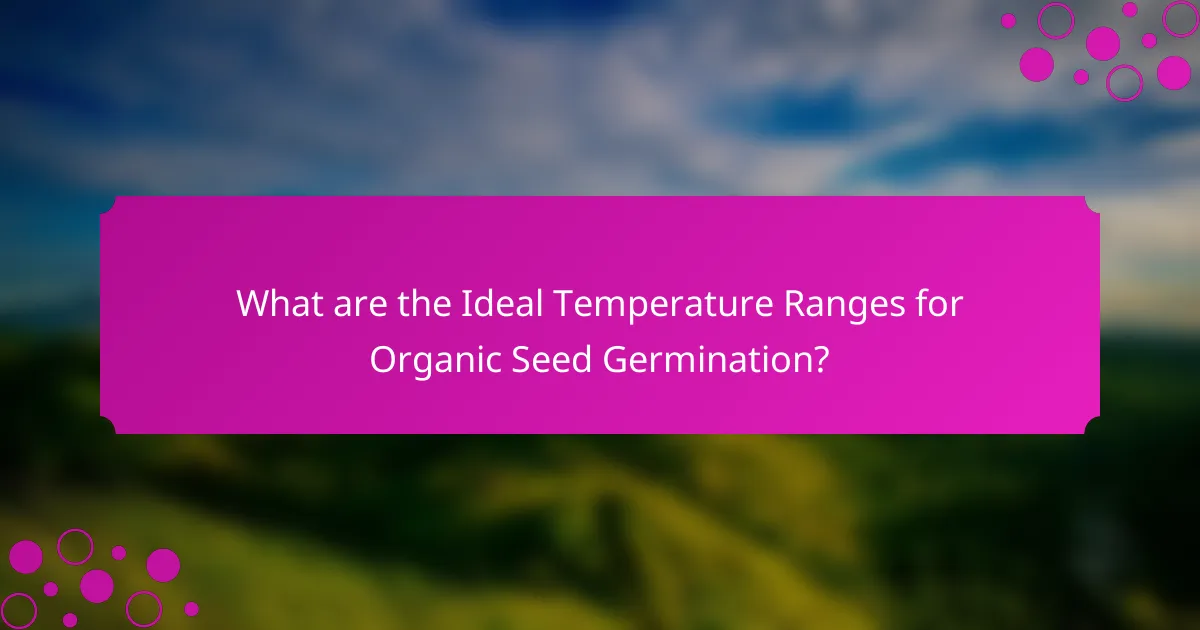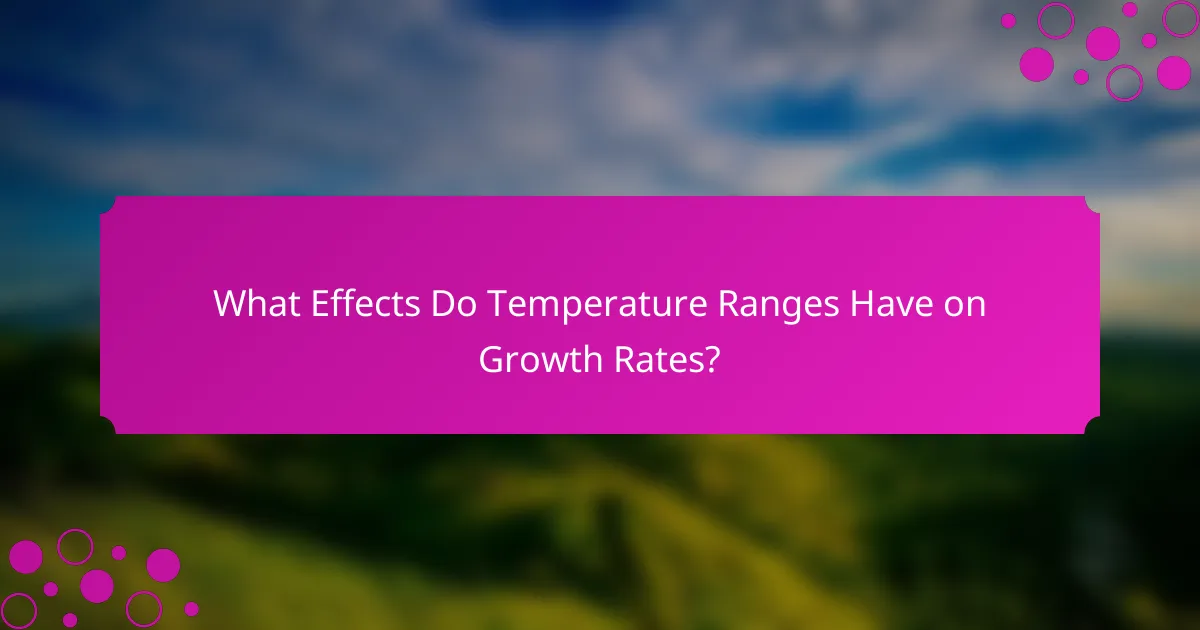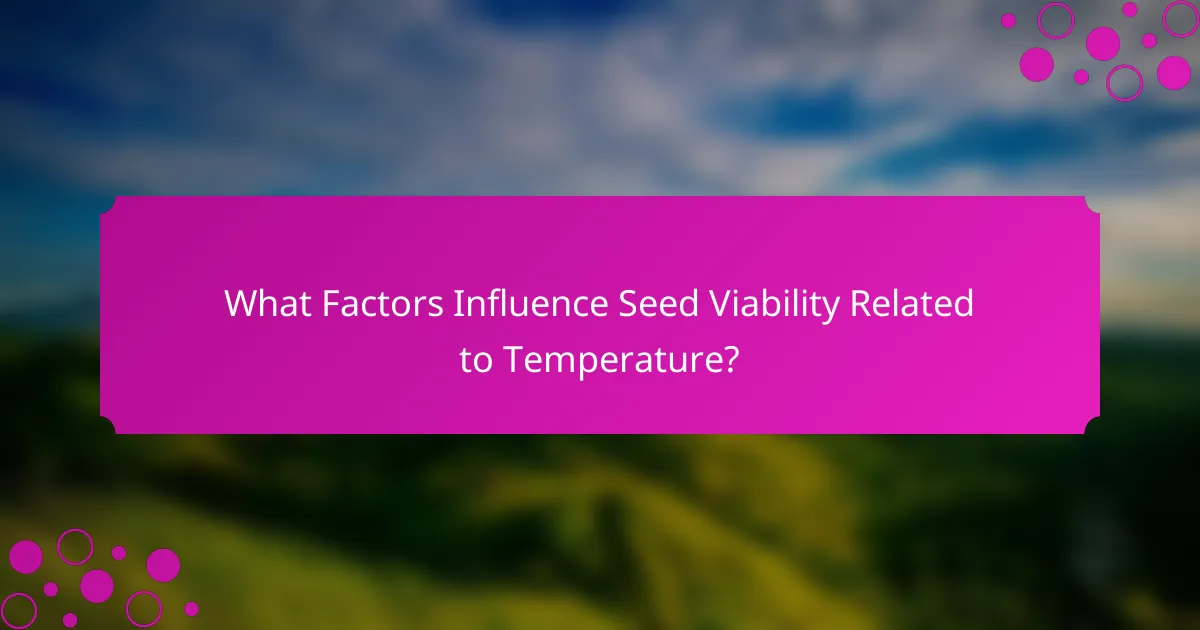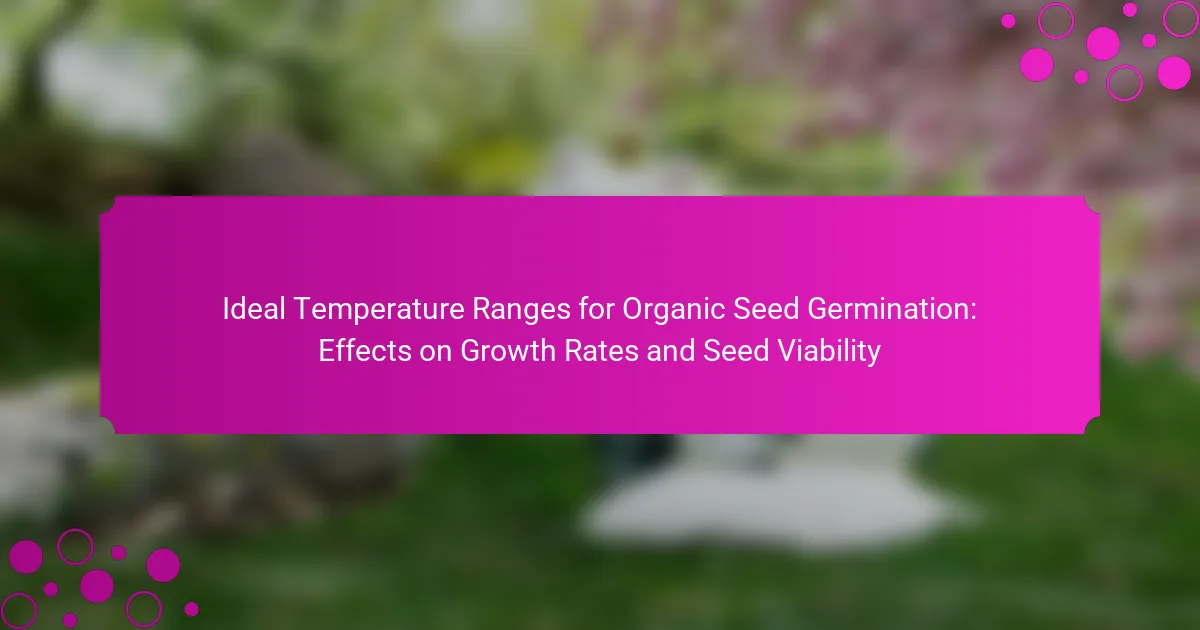The article focuses on the ideal temperature ranges for organic seed germination, emphasizing the critical role temperature plays in seed viability and growth rates. It identifies that most seeds germinate best between 65°F to 75°F (18°C to 24°C), with variations for warm-season and cool-season crops. The text highlights how optimal temperatures enhance metabolic processes, while extreme temperatures can negatively impact germination rates and seed health. Additionally, it discusses the relationship between temperature, moisture content, and seed viability, underscoring the importance of maintaining appropriate conditions for successful seed germination.

What are the Ideal Temperature Ranges for Organic Seed Germination?
The ideal temperature range for organic seed germination is typically between 65°F to 75°F (18°C to 24°C). Most seeds germinate best within this temperature range. Some seeds may require slightly higher or lower temperatures. For instance, warm-season crops may germinate at temperatures up to 85°F (29°C). Conversely, cool-season crops often prefer temperatures around 50°F to 65°F (10°C to 18°C). Proper temperature is crucial for maximizing germination rates and ensuring seed viability. Research indicates that temperatures outside these ranges can delay germination or hinder seedling development.
How do temperature ranges influence seed germination rates?
Temperature ranges significantly influence seed germination rates. Optimal temperatures promote faster germination, while extreme temperatures can hinder or delay the process. Seeds generally require specific temperature ranges to activate enzymes essential for germination. For many species, temperatures between 20°C to 30°C are ideal for germination. At these temperatures, metabolic processes accelerate, leading to quicker sprout emergence. Conversely, temperatures below 10°C may cause seeds to remain dormant. High temperatures above 35°C can damage seed tissues, reducing viability. Research indicates that temperature impacts not only germination speed but also overall seedling vigor. Studies show that consistent temperature conditions lead to healthier plants.
What specific temperatures are optimal for different seed types?
Optimal temperatures for seed germination vary by type. For example, tomato seeds germinate best at 70-85°F. Lettuce seeds prefer cooler conditions around 60-70°F. Peppers thrive at 75-85°F for optimal growth. Cucumber seeds germinate well between 70-95°F. Beans prefer a range of 70-90°F. Carrot seeds germinate best at 55-75°F. These temperature ranges are supported by research indicating that specific temperatures enhance germination rates and seed viability.
How do temperature fluctuations affect germination success?
Temperature fluctuations negatively affect germination success. Seeds require specific temperature ranges for optimal germination. Extreme fluctuations can lead to stress, inhibiting the germination process. Consistent temperatures promote uniform germination rates. Research shows that seeds germinated within their ideal temperature range exhibit higher viability. For example, a study by Baskin and Baskin (2014) indicates that seeds exposed to stable temperatures germinate more effectively than those subjected to variable conditions. This stability allows for better metabolic activity and enzyme function essential for germination. In contrast, excessive temperature shifts can cause dormancy or seed death. Thus, maintaining ideal temperature conditions is crucial for successful seed germination.
Why is understanding temperature crucial for organic seed viability?
Understanding temperature is crucial for organic seed viability because it directly influences germination rates and seed health. Seeds require specific temperature ranges to activate metabolic processes. Optimal temperatures promote enzyme activity, which is essential for germination. Conversely, temperatures that are too low can delay germination. High temperatures may cause seed damage or reduce viability. Research shows that many seeds have a narrow temperature range for optimal germination. For example, studies indicate that temperatures between 65°F and 75°F are ideal for many organic seeds. Understanding these temperature requirements helps in planning planting schedules and ensuring successful crop yields.
What role does temperature play in metabolic processes during germination?
Temperature significantly influences metabolic processes during germination. Optimal temperatures enhance enzyme activity, promoting seed metabolism. This includes the breakdown of stored nutrients into usable energy. Higher temperatures can accelerate these processes, leading to faster germination. Conversely, low temperatures can slow down or inhibit metabolic functions. Research indicates that many seeds have specific temperature ranges for optimal germination. For instance, some seeds germinate best between 20°C to 30°C. This range supports effective respiration and energy production. Temperature extremes can lead to seed dormancy or death, affecting viability. Thus, temperature plays a crucial role in germination success.
How does temperature impact the energy reserves of seeds?
Temperature significantly impacts the energy reserves of seeds. Higher temperatures can accelerate metabolic processes, leading to faster depletion of stored energy. Seeds typically rely on starches and oils as energy sources during germination. Optimal temperatures enhance enzyme activity, facilitating the breakdown of these reserves. Conversely, extreme temperatures can hinder germination and energy utilization. Research indicates that temperatures outside the ideal range can result in lower seed viability. For example, a study published in the Journal of Experimental Botany found that seeds exposed to excessive heat experienced reduced energy reserves, affecting growth rates. Thus, maintaining suitable temperature conditions is crucial for maximizing seed energy reserves and promoting successful germination.

What Effects Do Temperature Ranges Have on Growth Rates?
Temperature ranges significantly influence growth rates in plants. Optimal temperatures accelerate metabolic processes, enhancing seed germination and growth. For instance, many seeds germinate best between 20°C and 30°C. At these temperatures, enzymes function efficiently, promoting nutrient uptake and cellular division. Conversely, temperatures below or above this range can slow growth or lead to seed dormancy.
Research indicates that extreme temperatures can damage cellular structures, reducing viability. A study by Bewley et al. (2013) shows that temperatures exceeding 35°C can negatively impact seed germination rates. Additionally, prolonged exposure to low temperatures can inhibit growth and lead to poor establishment. Thus, maintaining ideal temperature ranges is crucial for maximizing growth rates in organic seed germination.
How does temperature affect the growth rate of seedlings?
Temperature significantly affects the growth rate of seedlings. Optimal temperature ranges enhance germination and growth. For most plants, temperatures between 65°F and 75°F (18°C to 24°C) promote ideal growth. At these temperatures, enzymatic activities increase, facilitating nutrient uptake. Conversely, temperatures below or above this range can slow growth or cause stress. For example, extreme heat can lead to wilting, while cold temperatures can delay germination. Studies show that seedlings exposed to optimal temperatures grow faster and healthier than those in unsuitable conditions. This relationship underscores the importance of temperature in seedling development.
What are the signs of temperature stress in growing plants?
Signs of temperature stress in growing plants include wilting, leaf scorch, and stunted growth. Plants may exhibit yellowing leaves or leaf drop as a response to extreme temperatures. Additionally, slow or halted flowering can indicate temperature stress. High temperatures often lead to increased transpiration, causing dehydration. Conversely, low temperatures can result in poor seed germination and root development. Research shows that temperature extremes can negatively affect photosynthesis rates. For instance, studies indicate that optimal growth occurs within specific temperature ranges, with deviations leading to stress symptoms.
How can temperature optimization improve crop yields?
Temperature optimization can significantly improve crop yields by ensuring that plants grow within their ideal temperature ranges. Optimal temperatures enhance seed germination rates, leading to quicker establishment of crops. Research indicates that many crops have specific temperature thresholds for maximum growth. For example, studies show that temperatures between 20°C and 30°C are ideal for many vegetables. When crops are exposed to suboptimal temperatures, growth can slow, and yield potential decreases. Additionally, temperature regulation can reduce stress on plants, allowing for better nutrient uptake. This results in healthier plants that are more resilient to pests and diseases. Consequently, optimized temperatures can lead to increased overall productivity and higher quality produce.
What are the long-term effects of temperature on plant development?
Long-term effects of temperature on plant development include altered growth rates, changes in flowering time, and impacts on overall plant health. High temperatures can accelerate growth but may lead to reduced seed viability. Conversely, low temperatures can stunt growth and delay maturity. Plants exposed to extreme temperatures often exhibit stress responses, affecting nutrient uptake and photosynthesis. Research shows that consistent temperatures above optimal ranges can decrease yield by up to 50%. Additionally, temperature fluctuations can disrupt plant physiological processes, leading to poor adaptation and increased vulnerability to pests and diseases.
How does temperature during germination influence future growth stages?
Temperature during germination significantly influences future growth stages. Optimal temperatures promote faster germination and stronger seedlings. Conversely, extreme temperatures can lead to poor germination rates and weak plants. Research indicates that seeds germinated at ideal temperatures show improved vigor and resilience. For example, a study found that maize seeds germinated at 30°C had higher growth rates than those at 15°C. This correlation between germination temperature and subsequent growth stages is crucial for maximizing crop yields. Therefore, monitoring and maintaining appropriate temperatures during germination is essential for healthy plant development.
What are the implications of temperature on plant health and productivity?
Temperature significantly impacts plant health and productivity. Optimal temperature ranges enhance seed germination, growth rates, and overall crop yield. For many plants, temperatures between 20°C to 30°C promote ideal growth conditions. Deviations from this range can lead to stress, reduced growth, and lower productivity. High temperatures can cause heat stress, leading to wilting and decreased photosynthesis. Conversely, low temperatures can slow metabolic processes and hinder germination. Research indicates that temperature extremes can reduce crop yields by up to 50%. Understanding these implications aids in optimizing agricultural practices for better outcomes.

What Factors Influence Seed Viability Related to Temperature?
Seed viability is significantly influenced by temperature. Optimal temperature ranges promote metabolic processes necessary for germination. Extreme temperatures can inhibit enzyme activity and disrupt cellular functions. High temperatures can lead to seed desiccation and death. Low temperatures can slow down germination or cause dormancy. Research indicates that most seeds have specific temperature thresholds for viability. For example, the ideal temperature for many crops like corn is between 20°C to 30°C. Deviations from these ranges can reduce germination rates and overall seed health. Temperature also affects moisture content, which is crucial for seed viability.
How does temperature affect seed longevity?
Temperature significantly affects seed longevity. Higher temperatures typically reduce seed lifespan. Seeds stored at elevated temperatures experience increased metabolic activity. This activity leads to faster depletion of energy reserves. Consequently, seeds lose viability more quickly. Conversely, lower temperatures generally enhance seed longevity. Cold storage slows down metabolic processes. Research indicates that seeds stored at 5°C can remain viable for years. In contrast, seeds stored at 25°C may only last a few months. Thus, maintaining optimal temperature is crucial for seed preservation.
What are the effects of high temperatures on seed storage?
High temperatures negatively affect seed storage by reducing seed viability. Elevated temperatures can lead to increased respiration rates in seeds. This process depletes stored energy reserves more quickly. High temperatures also accelerate the aging process of seeds. As seeds age, their germination rates decline significantly. Research indicates that seeds stored at temperatures above 20°C experience reduced longevity. For instance, seeds stored at 30°C can lose viability within a few months. Maintaining lower storage temperatures is essential for preserving seed quality and viability.
How can temperature management enhance seed viability in storage?
Temperature management enhances seed viability in storage by maintaining optimal conditions that prevent deterioration. Proper temperature control slows down metabolic processes in seeds. This reduction in metabolism decreases the rate of respiration and moisture loss. Ideal storage temperatures typically range from 0°C to 5°C for most seeds. At these temperatures, seed longevity is significantly increased. Research shows that seeds stored at lower temperatures can retain viability for years longer than those stored at room temperature. For example, a study found that seeds stored at 4°C maintained over 90% viability after five years, compared to only 50% at 20°C. Therefore, effective temperature management is crucial for extending seed viability during storage.
What are the best practices for maintaining ideal temperatures for seeds?
The best practices for maintaining ideal temperatures for seeds include using a temperature-controlled environment. Seeds germinate best within specific temperature ranges, typically between 65°F to 75°F (18°C to 24°C). Consistent temperatures promote uniform germination and healthy seedling development. Utilizing heat mats can help maintain desired soil temperatures, especially in cooler conditions. Monitoring soil temperature with a thermometer ensures optimal conditions are met. Avoiding temperature fluctuations is crucial, as extreme changes can hinder germination rates. Additionally, providing adequate ventilation prevents overheating and moisture buildup. These practices enhance seed viability and support robust growth rates.
How can growers effectively monitor and adjust temperature conditions?
Growers can effectively monitor and adjust temperature conditions by utilizing temperature sensors and climate control systems. Temperature sensors provide real-time data on the environmental conditions. This data allows growers to identify fluctuations that may affect seed germination. Climate control systems can include heating, cooling, or ventilation mechanisms. These systems can be automated for precise adjustments based on sensor readings. Regular calibration of sensors ensures accurate temperature monitoring. Research indicates that maintaining optimal temperature ranges significantly enhances seed viability and growth rates. For example, studies show that specific temperature thresholds can maximize germination rates for various seed types.
What tools and techniques are available for temperature management in seed germination?
Temperature management in seed germination can be achieved through several tools and techniques. Heating mats provide consistent warmth to seeds, promoting faster germination. Thermostats can regulate temperature, ensuring optimal conditions are maintained. Soil thermometers measure the temperature of the soil, helping gardeners adjust their methods as needed. Greenhouses offer controlled environments, protecting seeds from extreme temperatures. Additionally, row covers can insulate seeds from cold weather. These methods collectively enhance seed viability and growth rates. Proper temperature management is crucial, as many seeds require specific temperature ranges to germinate effectively.
What common challenges do growers face regarding temperature and seed germination?
Growers face several common challenges regarding temperature and seed germination. One challenge is maintaining optimal temperature ranges for different seed types. Seeds require specific temperatures for successful germination, typically between 65°F to 75°F for most species. Deviations from these ranges can lead to poor germination rates.
Another challenge is temperature fluctuations. Sudden changes in temperature can stress seeds and inhibit germination. Consistent temperature control is crucial for promoting healthy growth. Additionally, growers may struggle with inadequate heating or cooling systems in their growing environments.
These issues can lead to delayed germination and uneven seedling emergence. For instance, research shows that temperatures above or below the ideal range can reduce germination rates by up to 50%. Understanding these challenges is essential for improving seed viability and growth rates.
The main entity of this article is the ideal temperature ranges for organic seed germination, which are crucial for maximizing growth rates and seed viability. The article outlines the optimal temperature ranges for various seed types, emphasizing that most seeds germinate best between 65°F to 75°F (18°C to 24°C), while also detailing how temperature fluctuations can negatively impact germination success. Furthermore, it discusses the role of temperature in metabolic processes during germination, the long-term effects on plant development, and best practices for maintaining ideal temperature conditions to enhance seed viability and crop yields. Understanding these factors is essential for growers aiming to optimize agricultural practices and improve overall plant health.
